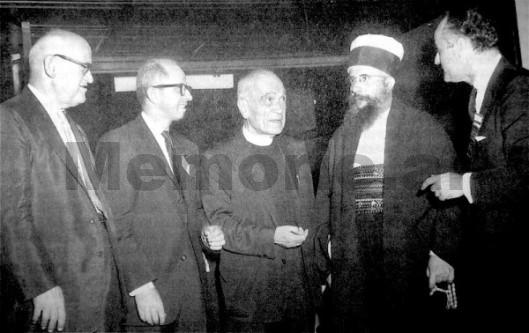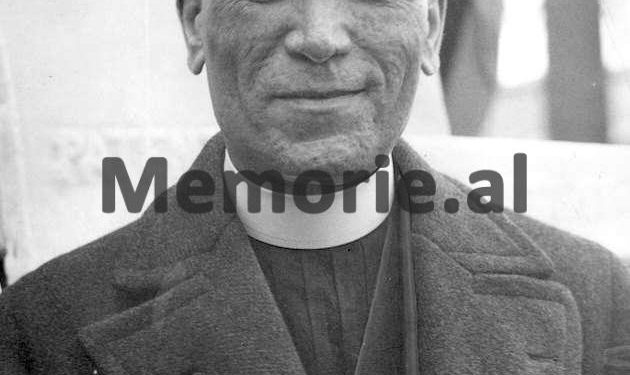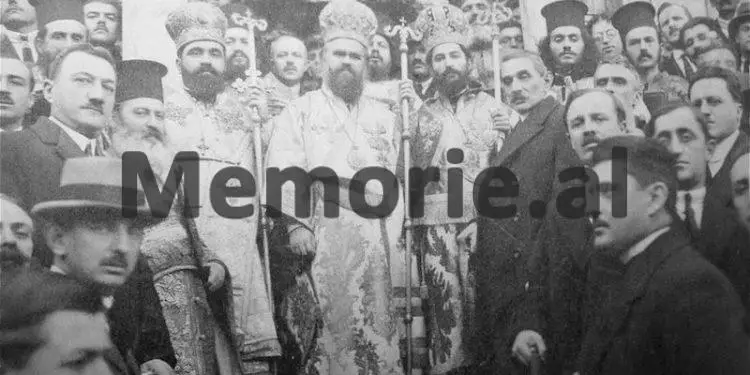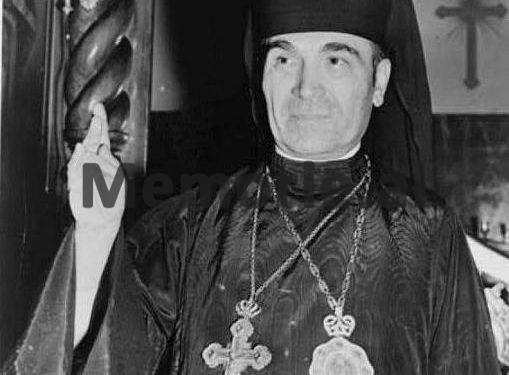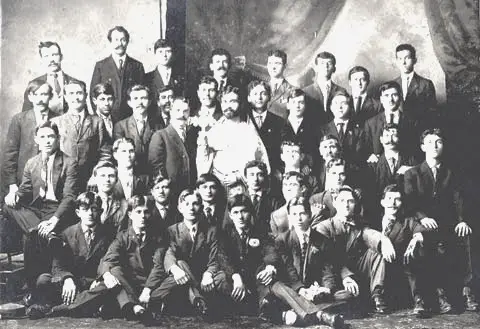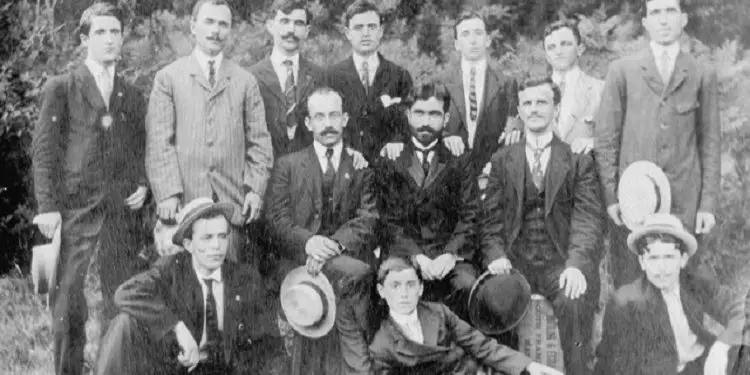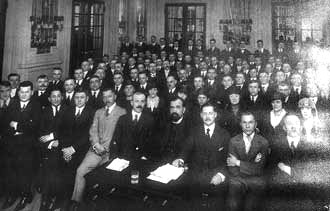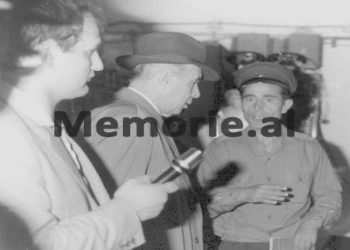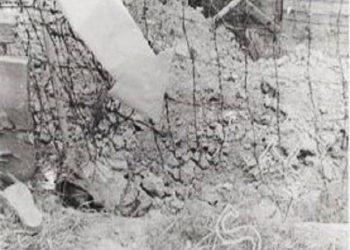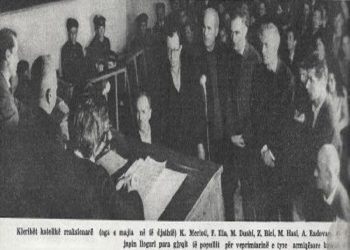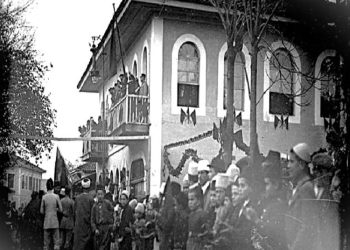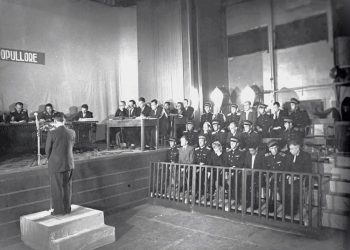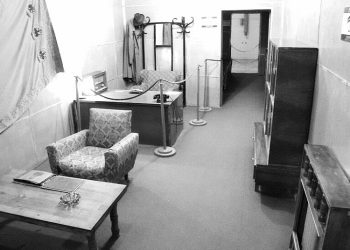By Agim Xh. Dëshnica
Part Two
Memorie.al / In 1937, on the occasion of the celebrations of the 25th Anniversary of National Independence, in the official publications of the Government of King Zog, it was written: “In the sky of the Albanian cultural world shine three unfading stars, Naimi, Noli and Fishta”! In the perfect albums with unedited photographs, alongside the prominent figures of the nation, the graceful portrait of Fan S. Noli also shone. That same year, Faik Konica would say: “Father Noli will remain in the history of Albania, as the man who was the first to achieve, thanks to his will and subtlety, to speak the Albanian language at mass. The day he celebrated mass for the first time is a white omen on the path of our progress. And we neither forget it, nor can we let others forget it”!
Continued from the previous issue
From a postcard with a view of the “Empire State Building”, sent to Xhevdet Dëshnica in 1931, after warm words of greeting, he writes: “… this high tower that this postcard shows… takes Tirana inside”!
Of the 281 published letters, only one appears with Zog. In which files do the others sleep? Such a treatment of correspondence and speeches, which belong to different phases of history, leaves dark shadows among Albanian readers. Their opposing judgment daily refutes the contemptuous attitudes towards the sons of our nation, well-known in world history.
Correspondence with people of letters, such as; Mitrush Kuteli, Milto Sotir Gura, Qerim Panariti, Ali Rexha, Xhevat Korça, Nexhat Peshkëpia, Arshi Pipa, Skënder Luarasi, etc., are of course valuable, but we do not see the letters with Faik Konica, Ahmet Zogu with concerns about the fate of the Homeland, nor the letters with Tajar Zavalani, nor with Llazar Fundo, with analyses and criticisms of communist ideas.
In 1996, in the reviews for “Biography and Correspondence”, professor Jorgaqi, instead of documents, uses his own conjectures and memories after memories of great-grandchildren. Their oral reports are poorer than the hazy memories of contemporary exiles. In the stream of introductions and prefaces, the numerous praises and stereotypical phraseology, confront and fade in the poorly selected subject. One thought clash with another.
As a critic who forgives nothing, he writes: “Subjectivism can appear in different ways, from hiding weaknesses and justifying mistakes to self-deprecation. Not even Noli’s Autobiography has escaped the latter.”
He further adds: “On the other hand, let us not forget that from the witness accounts it appears that Noli, after the mid-1930s (53 years old – A.D.) and especially in his old age, led the life of a solitary man, became skeptical and did not believe easily, did not like to remember the past, especially his political life and even more so to confess to the public” (!?).
But the stubborn facts speak differently. Even after the 1930s, Noli is at the peak of his patriotic and creative activity. He meets with Albanian exiles, gives lectures and talks about his life. The published letters do not speak at all about the real Noli. Correspondence with numerous friends and cultural personalities is almost absent. The professor collects letters from his colleagues and friends that have not withstood the test of time and makes them public in our days, creating mixed opinions about Fan Noli, about his faith in God, about his love for man, for freedom and the Fatherland.
Since he doubts the “Autobiography”, in the hope of discovering another origin, he visits Noli’s birthplace. The tales with “Theofanis Nolis” or “Theofanis Mavromatis” came to the mothers’ attention when putting their children to sleep. Noli’s anonymous letters are now known by the names: Ali Baba Qyteza, ABQ, Pesimisti, Mavromatis, Ali Asllan Qyteza, Ali Dyrmish Qyteza, Rrushit Bilbil Gramshi, Theofani, Bajram Domosdova, Namik Namazi, etc.
To complete the portrait of Fan Noli, only the correspondence with Ismail Qemali, Ahmet Zogu, Faik Konica, Gjergj Fishta, Mit’hat Frashëri, etc. would be enough. Also letters with George Bernard Shaw, Thomas Mann, Franz Babinger, Jean Sibelius, etc.
The Pens of Truth
In the time of democracy, truth emerges from its lethargy and speaks with a series of books: “Konica”, by Prof. Dr. Jup Kastrati (1995), “Noli i Panjohur”, by Dr. Eftim Dodona (1996), “Federata Pan-alqiptare Vatra” (2002), by Prof. Dr. Beqir Meta, “Albania and the National Problem, 1918-1928”, by Dr. Lush Culaj.
In the newspaper ‘Dielli’, we come across writings by Petër Prifti, At Artur Liolin, Prof. Robert C. Austin, Anton Çefa, etc. Meanwhile, the professors of socialist realism begin to retouch previous writings with poor quality.
The EU’s demand for the condemnation of the crimes of communism reminds us of Orthodox Bishop Theofan from 1946, with his harsh criticism of the “behavior of the Tirana authorities”, just as Catholic Father Zef Pllumi does today with his scathing testimony about the crimes of communism in Albania.
Noli and Communism
Just as before and after 1946, Fan S. Noli had no illusions about the communist system, both in Albania and in the world. It is enough to read the negative assessment of the “Communist Manifesto”. Noli’s true manifesto is the enlightened creation, “The Hymn of the Flag”. For the ideas conveyed by this optimistic poem, only two stanzas are enough:
“O blood Flag, O vulture Flag,
O home and homeland, O mother and father,
Wet with tears, burnt with the flag,
Red Flag, Black Flag!
Flag that bears Saint Castanh,
Reconciles Islam and Christianity,
Declare brotherhood among religions,
Generous Flag for Humanity”.
On October 18, 1951, Noli announced: “I am not and have never been a member of a communist organization. I have never in my life preached a communist or pro-communist or anti-American sermon. On the contrary, I have extolled the democratic American way of life and emphasized the historical fact that Albania owes its independence primarily to America and, in particular, to President Wilson. My church, nor I, have ever been under the jurisdiction of any foreign Synod or Patriarchate, communist or otherwise. As the Albanian Orthodox Church in America, which I preside over, it is administratively independent.
I have nothing to do with the appointments or resignations of Bishops or Archbishops in the Orthodox churches of Albania. Therefore, I am not responsible in any way for the resignation of Archbishop Kisi and the appointment of his successor, Archbishop Vodica.”
In the preface to “Album –II” 1966, Qerim Panariti writes: “Noli’s opponents have not given up even today, to put a red stamp on him; they have not given up even today, when Noli is no longer with us to own himself. If Noli’s opponents had only a quarter of a dirham in their heads and a little nobility, they would have taken it into their heads, that even if Noli wanted to establish diplomatic relations with the Soviet Union, the political conditions in Albania in December, 1924, were so sad, that Noli was almost preparing to leave Albania, forever”!
Father Artur Liolin, January 30, 2007, “Noli and Communism”: “After Noli learned about the atrocities of the communist regime in Albania, he distanced himself, which is clear when he refused to ever return to Albania, neither to receive the titles offered by the Communist Government – certainly for dark compromising purposes – nor for scientific research, nor to enter into obscure religious matters…!
In the end, how could the Massachusetts state senate invite Noli to give the blessing of the opening of the 1963 sessions, if Noli were a “communist”?! Or how could President Lyndon Johnson invite the “communist” Noli specifically to the White House in July 1964, to bless in Washington and give the speech on the occasion of the 400th anniversary of Shakespeare? The arguments otherwise do not hold water.”
Fan Noli’s story, the arguments of Qerim Panarit and Father Artur Liolini, are as clear as sunlight, about his stance towards communism. So, no matter how many analysts, among them very good ones, find different stances in political life in accordance with the stages of development of historical events, the path of the patriot trodden by him, clearly seems to be heading towards the gilded European and American West, for the happiness of the people and the flourishing of the Fatherland.
Noli’s commemoration
On the occasion of the 100th anniversary of Noli’s birth, in the newspaper “Bashkimi” in Tirana, a critical article against Fan Noli was published, prepared by the supposedly “Nolist” writers, signed by Enver Hoxha. For the party members, this article was an order not to participate in the commemorative Conference! Many invitations were canceled. The Assembly Hall previously scheduled was replaced with the small hall of the Higher Institute of Arts. In the middle of the presidium, illuminated by spotlights, stood the dictator’s bust. In the upper right corner, the reduced photo of Noli, lost in the twilight.
For whom was the memorial meeting being held, for Fan Noli or Enver Hoxha?! Those who were sitting upstairs were told to come down and, together with the listeners at the back of the hall, approach the front rows. In those moments when you glanced at the photo in the corner and listened to the professors’ announcements, you had the impression that Noli, in protest, had left the hall. Meanwhile, “Vatra” and UNESCO, in special meetings and scientific conferences, commemorated him with honor, as befits the son of the Albanian Nation, Theofan Stilian Noli.
In Albania, no monument was erected. His name was not placed in any scientific institution, not even in any high school. Through truncated publications, it was understood that the number of Noli’s works should not have reached high levels. In the palace of the Academy of Sciences, numerous photographs of the dictator were hung everywhere and his bust was whitened in front of the meeting hall. Suddenly, an employee of the Academy discovered in the Archaeological Center, among boxes covered with cardboard, paper and dust, the bust of Skanderbeg, the work of the prominent sculptor Odhise Paskali. He recovered it and carried it to the Academy.
Times changed, the Iron Curtain was torn, the Berlin Wall collapsed, the statues of tyrants were toppled. At the headquarters of the Academy of Sciences, the photographs and the white bust of the dictator disappeared. Now every visitor breathes freely when contemplating two busts, Skanderbeg and Fan S. Noli.
Noli and today’s distorters
In 2006, Prof. Jorgaqi did not wait any longer. After many others, he managed to finish the book “The Life of Fan Noli”. In promoting the book, he said: “I have worked for 20 years on this book and I managed to reconstruct the life of Fan Noli” (?!). But can the life of a genius be reconstructed? Does it belong to those who tried to destroy it for 45 years? And could those who have never knocked on the door of “Vatra” be able to perform this honorable work?
Apparently, the published articles and lectures as a lecturer, starting from the 70s, after hasty retouching and according to old beliefs, he included in this book, where he casts the fog over Noli in a new form, but the pure wind of truth pushes him further, beyond the mountains. As far as we know, a new version of Noli’s works is circulating in bookstores, almost similar to the five volumes published by the Academy of Sciences in 1988.
Jorgaqi comes to the fore again. In the overview of the subject of “Album” – 1948, we see the revival after 60 years of the master of criticism, the unforgettable Mitrush Kuteli. Finally, “Album II”, prepared by Qerim Panariti in 1966, in Boston, is also listed, damaged. From the History of the Albanian Church in America, important parts are noted to have been omitted. The fabrication, “Portraits and Sketches”, rises again. For Albanian-speaking Albanians, “Beethoven and the French Revolution”, is also available in English. The fourth volume is packed with journalism from archive newspapers.
The “Here and There” columns are filled with announcements and events in deserts and distant places, forgotten by history. At the end, the anti-Nol translator of the slanderous letter, Spiro Xhai, from Athens, appears again. We are watching with amazement how pensioners, who no longer create, readily take Nol’s creativity and, with the help of skilled computer scientists, fill books without a scientific level, putting them on the market for business and other purposes.
Albanian reality is experiencing every day the feverish efforts of some professors to rehabilitate the culprits who, for years, destroyed the national values of our country, while simultaneously trying to obscure the work of the sons of our nation, well known in world history, such as; Noli, Zogu, Konica, Fishta, etc. How long will this continue?! Memorie.al




